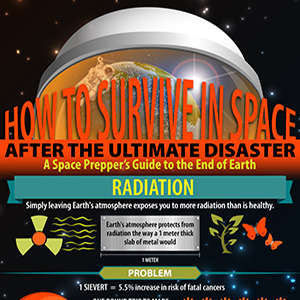How to Survive in Space After the Ultimate Disaster
Prepper’s guide to surviving in space
Could humanity actually survive the ultimate emergency: the end of the world? From black holes to starvation, these are the essentials when it comes to surviving in space after a disaster destroys our Mother Earth.
Radiation
Simply leaving Earth’s atmosphere exposes you to more radiation than is healthy.
Earth’s atmosphere protects from radiation the way a 1 meter thick slab of metal would.
Problem:
1 Sievert = +5.5% rise in risk of fatal cancers
One round trip to Mars = .66 Sieverts
The equivalent of a full body CT scan every 5-6 days.
Solution:
Prolonged habitation on planets with weak atmospheres would require living underground.
Or,
A magnetosphere (for spaceships):
Magnetic fields like what earth is encased in can deflect radiation.
Shields need to be made of fibers.
Bulky materials are weak with spaces and imperfections.
A spider’s web is strong because it is made of individual unbroken threads.
Radiation sensors can alert space travelers when they need to be behind shields.
Starvation
It costs $10,000 per lb of food sent to the International Space Station–we’re going to need to grow food as we fly.
Astronauts currently get 3.8 pounds of food per day.
This is 7,000 lbs of food per person to get to mars and back.
Introducing Space Farming!
FOR SPACECRAFT GROWTH, consider:
Plant size
Antioxidants (fights radiation)
Quick growth time
No processing equipment required
Good candidates:
Lettuce
Spinach
Carrots
Tomatoes
Spring unions
Cabbage
Radishes
This keeps you fed, but growing food also:
Reduces stress
Improves mood
Alleviates depression
Promotes social growth
Pushes mental and physical rehabilitation
And increases resistance to general illness.
FOR GROWTH ON FOREIGN PLANETS, consider terraforming:
Ideally leading to an ecosystem, with oxygen produced
Carbon dioxide reduced,
And water recycled.
Space Dust
Wait…Moondust can be deadly?
It is the consistency of flour… so it:
Slips through gaps in equipment,
Is easily kicked up,
Sticks to people
Causing:
Radioactive exposure,
Allergic reactions,
Lung cancer from inhalation.
And Mars dust might be worse.
Space Junk
Debris that orbits the earth travels at 17,500 mph.
Orbiting for millions of years.
Even a small fleck of paint
Can disable a middle-sized spacecraft.
–> Any collision then makes more spaces of space junk.
Static Electricity
Yes…static electricity can disable equipment in space.
In humid conditions, water conducts electrons off of our body.
Space is incredibly dry.
Every time equipment touches other objects in space
chance for equipment crippling static electricity occurs.
NASA has a reverse lightning rod.
Black Holes
Once you’re past the event horizon, that black hole isn’t letting you go.
Event horizon: the point around a black hole where gravity is so strong that light and radiation can’t escape.
–Meaning– We can’t see past the event horizon.
Small black holes(the size of earth) are extreme.
To get pulled past the event horizon
Would instantly turn you into a stream of subatomic particles.
Larger black holes give you more time (literally)
As you accelerate faster and faster you move through time more slowly.
Things falling into the hole in front of you slow in time more.
So in front of you, you can see things previously fallen into the hole
And behind you, you can see things from the future, rapidly approaching you.
Meanwhile you’ll “spaghetifi” because the gravity on your head (or whichever end is falling into the hole first)
will be so much more than that on your feet.
Water
Turns out there is water in space. [11]
Interplanetary dust contains both hydrogen and oxygen, at times mixing to rain down on surfaces.
Interplanetary dust is also the most carbon-rich meteoric substance.
With 30,000 – 40,000 tons of interplanetary dust raining onto Earth yearly
It could have been the origin of life on Earth.
–> And it could sustain us in space in the future.
So surviving in space isn’t a cinch. There’s a reason it’s called the final frontier.
Citations:
- http://www.space.com/21353-space-radiation-mars-mission-threat.html
- http://www.nasa.gov/vision/space/travelinginspace/radiation_shielding.html
- http://www.cnn.com/2013/06/27/world/europe/star-trek-shield/
- http://modernfarmer.com/2013/09/starship-salad-bar/
- http://news.discovery.com/space/history-of-space/kitchen-mars-astronauts-110829.htm
- http://www.sciencedaily.com/releases/2013/03/130328075708.htm
- http://www.cracked.com/article_19158_the-6-weirdest-dangers-space-travel.html
- http://www.wired.com/science/space/news/2005/04/67110
- http://library.thinkquest.org/03oct/01581/SpaceTravelEnglish/dangers/spacedebris.html
- http://www.livescience.com/19683-happen-fall-black-hole.html
- http://www.space.com/24422-solar-wind-makes-water-star-dust.html

